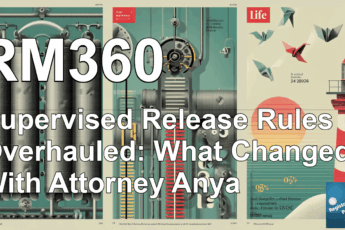The legislative session in New Mexico has officially wrapped up, and it was anything but quiet. Over the course of 60 days, a flurry of bills was debated, challenged, and either passed or defeated—all while stirring public discourse around criminal justice reform and public safety. For advocates working to prevent overreach in laws impacting certain populations, this session was particularly momentous, with significant battles fought and, in their eyes, victories achieved.
In this blog post, we’ll break down some of the most hotly contested bills of the session, provide insights into the legislative process, and highlight the broader implications of these decisions. Whether you’re tuning in as a policy enthusiast, legal professional, or advocate for criminal justice reform, this article will deliver both substance and context.
How Legislative Sessions Work in New Mexico: A Primer
Before diving into the specific legislative successes and failures, it’s important to understand the mechanics of New Mexico’s legislative process. The state operates on a biennial schedule of alternating 30- and 60-day sessions, with this year being a full-length 60-day term. During this period, proposals must navigate various stages, including committee reviews in both chambers, floor debates, and final votes.
Bills that fail to pass within the session’s time limits are considered “dead,” meaning advocates for or against specific legislation often find themselves racing the clock—a theme that emerged repeatedly this year.
Key Legislative Battles: Bills That Shaped the Debate
New Mexico’s 2025 legislative session saw numerous proposals aimed at reshaping criminal justice policy. Here’s a closer look at the most talked-about and controversial bills—and their ultimate fates.
1. House Bill 73: Eliminating the Statute of Limitations for Childhood Sexual Abuse Cases
- Proposal Overview: This bill sought to eliminate the statute of limitations for civil lawsuits in cases of personal injury stemming from childhood sexual abuse. Currently, the statute of limitations hinges on the victim’s age or when the abuse was first disclosed to a medical provider.
- Outcome: Defeated in the Senate. Despite passing the House unanimously, the bill failed to gain traction in the Senate, where it ultimately died.
- Analysis: Advocates argue that removing the statute of limitations would empower survivors to seek justice, even years after the abuse occurred. However, concerns were raised about balancing justice with fairness, particularly for cases relying on decades-old evidence.
2. House Bill 86: Expanding the Definition of Human Trafficking
- Proposal Overview: This bill proposed a broader definition of human trafficking to capture activities indirectly linked to exploitation and abuse.
- Outcome: Defeated in the House Judiciary Committee. It never made it to a full floor vote.
- Why it Matters: According to experts, bills like this can inadvertently cast a too-wide net, penalizing individuals who may not have engaged in trafficking but were loosely associated with its key players.
3. House Bill 87: Clarification of Nonconsensual Touching Laws
- Proposal Overview: This bill aimed to clarify legal definitions and tighten restrictions around nonconsensual physical contact.
- Outcome: Died on the Senate floor calendar. While it made substantial progress, time ran out before the Senate could take a final vote.
- Legislative Process Insight: This bill’s death highlights one of the challenges of the legislative process: A limited session means time management becomes a make-or-break factor for many proposals.
4. House Bill 322: Increasing Penalties for Serious Crimes
- Proposal Overview: In response to concerns about rising crime rates in New Mexico, this bill proposed harsher penalties for specific offenses, including the reinstatement of the death penalty in cases of severe sexual violence and human trafficking.
- Outcome: Killed in its first committee hearing.
- Bigger Picture: Advocates against the bill argued that introducing harsher penalties does little to address root causes of crime, such as poverty and lack of educational opportunities. Critics also labeled such measures as overly punitive and misaligned with evidence-based criminal justice reform.
5. House Bill 385: Chemical Castration for Offenders
- Proposal Overview: This highly controversial bill proposed allowing chemical treatment to suppress sexual urges in specific criminal cases.
- Outcome: Dead on arrival. The proposal didn’t even receive a hearing, aligning with predictions that the measure would fail to gain support.
- Public Response: Bills like this often ignite impassioned debate, with supporters describing them as tools for public safety and opponents condemning them as inhumane.
6. Senate Bill 74: Removing Statutes of Limitations for Certain Crimes
- Proposal Overview: Among its provisions, this bill proposed eliminating limitations for prosecuting offenses like human trafficking and expanding definitions of the crime to include terms such as “harboring” or “maintaining.”
- Outcome: Defeated. The bill faced significant criticism for its vagueness and potential to criminalize vague or indirect associations with illegal activity.
- Why Advocates Opposed It: Expanding the definitions of human trafficking and related crimes can create unintended consequences, such as unjustly ensnaring individuals in criminal proceedings based on circumstantial evidence.
Advocacy Efforts That Made a Difference
The successful prevention of these bills didn’t happen by chance. According to Larry, a longtime advocate and expert in legislative affairs, victories were a result of collaborative efforts among multiple organizations. Groups such as the New Mexico Criminal Defense Lawyers Association and the State Office of the Public Defender contributed data-driven insights to legislative committees, helping decision-makers understand the potential impact of proposed bills.
Larry also emphasizes the importance of presenting compelling, factual data rather than relying purely on emotional appeals. “We come in with reams of recidivism data and cost-analysis reports,” he explained. This approach has proven effective in stark contrast to well-intentioned but less persuasive emotional rhetoric often employed by advocacy groups.
Factors Driving Crime in New Mexico
A recurring theme throughout the session was New Mexico’s elevated crime rate. While certain lawmakers advocated for stricter punishments, critics pointed to deeper societal issues as contributing factors:
- Economic Challenges: High levels of poverty correlate strongly with elevated crime rates.
- Educational Disparities: Persistent underperformance in education—a ranking near the bottom nationally—limits opportunities for upward mobility.
- Substance Abuse Rates: New Mexico also struggles with high rates of addiction, particularly alcoholism, further exacerbating criminal behavior.
Understanding these root causes creates opportunities for systemic improvements that go beyond simply increasing penalties or expanding definitions of crime.
Concluding Insights
New Mexico’s 2025 legislative session proved to be a significant battleground for those advocating against overly punitive criminal justice measures. By preventing the passage of multiple controversial bills, advocates demonstrated the power of collaboration, data, and strategic legislative engagement.
Key Takeaways for Advocates
- Timing is Everything: Legislative time constraints can often derail even comprehensive proposals. Effective advocacy means monitoring the calendar closely and strategizing accordingly.
- Evidence over Emotion: Policymakers are more likely to respond to solid data and reports than solely emotional appeals.
- Collaboration Works: Success frequently hinges on partnerships between advocacy groups, defense associations, and state-level organizations committed to justice reform.
New Mexico’s legislative process offers a valuable blueprint for advocates nationwide. As emerging challenges and debates around criminal justice continue to evolve, the lessons learned here will undoubtedly resonate beyond state boundaries.
For Readers: Are you an advocate working in your state to push for or challenge important legislation? Share your experiences with us in the comments or email us at registrymatterscast@gmail.com. We’d love to hear what’s happening where you live—and how you’re making change happen.





Leave a Comment